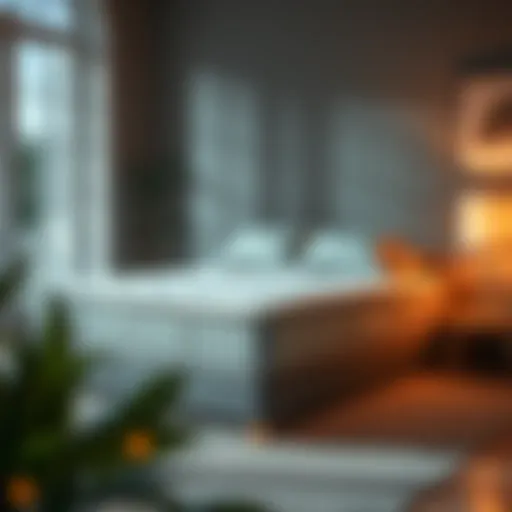The Impact of Large Asymmetrical Mirrors in Design


Intro
In the realm of interior design, one can hardly overlook the profound impact of large asymmetrical mirrors. These reflective pieces do more than just help us check our appearance before dashing out the door; they play a pivotal role in shaping the ambience and spatial dynamics of our living spaces. As we navigate through the in's and out's of modern homes, these mirrors emerge as versatile accents, blending functionality with striking visual artistry.
Furniture Styles and Trends
Modern vs. Traditional: Understanding the Aesthetics
By juxtaposing modern designs with traditional aesthetics, the unique contribution of large asymmetrical mirrors becomes evident. In modern settings, these mirrors often adopt sleek lines and inventive shapes that defy conventions, making a bold statement. They can become the centerpiece of a minimalist room, drawing attention without overwhelming the visual space. Conversely, in traditional setups, they may take on ornate frames while still maintaining an asymmetrical form, bringing a sense of charm and history to the environment.
This contrast highlights a key point: large asymmetrical mirrors possess the ability to bridge various design styles. For instance, placing a contemporary mirror in a classic room can create an intriguing visual dialogue, encouraging visitors to look deeper and notice the nuances of each style.
Color and Material Trends: What's In and What's Out
The color palette and material choices also shift depending on the latest trends, affecting how asymmetrical mirrors are perceived. Today, organic materials such as wood and metal are favored, marrying nature with modernity. Muted tones of earthiness blend beautifully with the varied aesthetics of asymmetrical mirrors, allowing them to seamlessly integrate into different settings.
Current popular colors include deep blues and emerald greens, which can create a striking backdrop for a reflective piece. By intentionally choosing colors that resonate with the surrounding decor, homeowners can enhance the mirror's allure and overall impact.
With more consumers focusing on sustainability, utilizing mirrors crafted from reclaimed or eco-friendly materials can not only align with personal values but also support a broader environmental mission.
"Mirrors serve as dynamic elements in design—not just reflecting spaces but also refracting the styles that lie within them."
Practical Considerations for Placement and Use
When it comes to using asymmetrical mirrors effectively, placement is crucial. Here are some worthwhile pointers:
- Eye Level: Mount mirrors at eye level to maximize their effectiveness. This can ensure they fulfill their functional role while adding artistic flair.
- Reflective Surfaces: Think about what the mirror will reflect. Position it to bounce light around or to highlight a piece of art or a beautiful view outside.
- Layering: In larger spaces, consider clustering several mirrors of varied shapes and sizes, making a cohesive gallery wall that enhances depth and intrigue.
By following these suggestions, homeowners can elevate the utility and aesthetic charm of their large asymmetrical mirrors, making them integral to the overall design.
Ending
As we delve into the multifaceted significance of large asymmetrical mirrors in contemporary interior design, it becomes clear they offer much more than mere reflection. They are an expression of individuality, style, and thoughtful design. By understanding their place in the broader narrative of home decor—through trends, styles, and practical application—homeowners and design professionals alike can leverage these striking pieces to transform their living spaces.
For further exploration on interior design trends, resources such as Britannica, Wikipedia, and various forums on Reddit can offer additional insights and inspiration.
Foreword to Large Asymmetrical Mirrors
Large asymmetrical mirrors have become quite the talking point in interior design, largely because they bridge both aesthetics and functionality in unique ways. These mirrors aren’t just reflective surfaces; they serve as transformative elements in a room. Their non-traditional shapes and sizes break the monotony often found in typical mirror designs, allowing homeowners and designers to express creativity and personal style.
By integrating these mirrors into a room, you are not only enhancing its style but also playing with the perception of space. For example, a large asymmetrical mirror can make a small area feel more expansive, reflecting light in a way that brightens dark corners. This functionality makes them valuable tools in both residential and commercial interiors.
The importance of exploring large asymmetrical mirrors lies in understanding their multifaceted role. They can act as artistic statements, harmonizing with eclectic decor, while also serving practical purposes. Homeowners often find that these mirrors fit seamlessly into various design styles, whether it’s chic modernity or cozy bohemian vibes.
Asymmetrical mirrors encourage a departure from conformity. They invite conversations around design choices and can act as focal points or subtle enhancements. This article will delve deep into how these mirrors can rejuvenate spaces, offering a blend of style, dimension, and practicality—all while appealing to a variety of tastes.
"Mirrors can open up space and add depth, while asymmetrical designs can redefine how we perceive our environments."
In summary, large asymmetrical mirrors deserve attention not just for their looks but for their abilities to alter the ambiance of a room. They are versatile, intriguing, and add an aesthetic kick to any space. Delving into the particulars of these mirrors will enable both homeowners and designers to leverage their full potential, ensuring that every reflection contributes positively to the atmosphere.
Historical Perspective on Mirror Design
Understanding the historical evolution of mirror design provides invaluable context for contemporary applications, especially in the realm of large asymmetrical mirrors. This perspective sheds light on how mirrors have transcended mere functionality to become significant aesthetic and cultural artifacts.
From ancient civilizations crafting polished bronze and stone surfaces to modern glass techniques, the evolution of mirror shapes reflects socio-economic and artistic trends of the times. The way we perceive and utilize mirrors in our environments is heavily influenced by this rich tapestry of history, capturing a range of human emotions and ideals.
Evolution of Mirror Shapes
The journey of mirrors began several millennia ago, with the earliest forms discovered in Mesopotamia dating back around 4000 BC. These rudimentary mirrors were made from polished stones and metals, serving primarily utilitarian purposes. In contrast, as glassmaking techniques advanced during the Roman Empire, mirrors evolved into beautifully crafted pieces that adorned the homes of the affluent.
By the Middle Ages, mirrors had stepped into the realm of artistry, boasting intricate designs and varied shapes that transformed them into focal points within lavishly decorated castles and churches. The Renaissance heralded a golden era for mirror design, bringing forth innovations such as the silvered glass mirror. This created a significant jump in reflective clarity and aesthetic appeal.
- Key developments included:
- The rise of Venetian glassmaking in the 16th century, famous for its delicate, ornate mirror designs.
- The incorporation of frames that complemented architectural styles across Europe.
- The transition to more abstract shapes during the Art Deco period as artists began to explore asymmetry.


As mirrors transitioned into the modern age, the focus shifted toward creating visually striking pieces that could redefine spaces. Large asymmetrical mirrors became a canvas for personal expression, with designers experimenting with unconventional shapes and dimensions. This progression indicates that today's mirrors are not just items for reflection; they are vital components of interior design.
Cultural Significance of Mirrors
Mirrors possess profound cultural weight, often symbolizing introspection, vanity, or wisdom in differnt cultures. Generally, they are seen as portals that reflect not just physical appearance, but also deeper personal truths. For example, in many Eastern philosophies, mirrors are used as tools for self-discovery, inviting individuals to confront their innermost thoughts.
In various societies, mirrors have held the status of talismans, used to ward off evil spirits or attract fortune. The mystical allure of mirrors finds its way into literature and art, from Lewis Carroll's "Through the Looking-Glass" to Gustave Courbet's provocative paintings capturing themes of vanity and reality.
- Examples of cultural significance include:
- In Chinese tradition, mirrors are often hung in homes to redirect negative energy.
- In Western art, the reflection seen in mirrors has sparked a dialogue about identity and duality, illustrating the complexity of human nature.
Understanding these dimensions is critical, as it highlights the crucial place mirrors occupy in our lives beyond practical utility. As we continue to embrace large asymmetrical mirrors in our spaces today, we pay homage to their compelling history and cultural meanings.
Defining Asymmetrical Mirrors
As we delve into the contours of large asymmetrical mirrors, it’s essential to underscore what precisely defines this unique form. These mirrors stand out from their symmetrical counterparts by embracing disorder, creating shapes that defy traditional notions of balance. They often mirror the complexities of life, reflecting not just images but also emotions and ambiance.
Their importance in the realm of interior design cannot be overstated. Asymmetrical mirrors serve as bold statements, adding interest and depth to spaces. They can transform a room destined for monotony into one that breathes creativity and character, taking on forms that provoke intrigue and inspire conversations.
Characteristics of Asymmetry
The splendor of asymmetry lies in its imperfection. Much like nature itself, where no two leaves are identical, asymmetrical mirrors celebrate uniqueness through vivid shapes and unconventional designs. Here are some defining characteristics:
- Diverse Shapes: Asymmetrical mirrors can range from organically shaped flowing lines to sharp, jagged forms. This diversity allows them to fit both contemporary and eclectic styles, rendering them versatile accents in various settings.
- Visual Impact: The non-conformity of these mirrors creates a dynamic focal point within a room. A large mirror placed strategically can draw the eye, making it not just a reflective surface but a piece of art.
- Personal Interpretation: Unlike traditional mirrors that adhere to a fixed geometric form, asymmetrical mirrors invite subjective interpretation. Viewers often have differing reactions, as the mirror might evoke different narratives based on angles and light.
Materials and Finishes Used
When it comes to construction, large asymmetrical mirrors utilize various materials that enhance their appeal and durability. The choice of material not only affects the aesthetic but also the functionality of these mirrors. Key materials include:
- Glass: High-quality glass is a common choice due to its reflective properties. Designers often prefer tempered glass for larger mirrors, ensuring safety without compromising style.
- Metal Frames: Asymmetrical mirrors frequently sport frames made from metals like brass or steel. These frames can range from polished finishes to matte coatings, making them adaptable to different design aesthetics.
- Wood Accents: Combining glass with wooden features can produce a warm, inviting look. Whether it's reclaimed wood for a rustic vibe or sleek, modern lines, wood adds texture and character.
- Mixed Media: Some designers opt for unconventional materials like resin, acrylic, or even textiles, creating mirrors that are boundary-pushing both in aesthetic and functionality.
These options for materials and finishes showcase how asymmetrical mirrors don’t just function as reflective surfaces; they embody artistic expression, aesthetics, and practical elements of design. Thus, more than just decoration, they are integral parts of contemporary home decor.
Spatial Dynamics of Large Mirrors
The spatial dynamics of large mirrors play a vital role in contemporary interior design. Understanding how these mirrors influence the dynamics of a room helps homeowners and designers make informed choices about their placement and usage. Large asymmetrical mirrors are not just decorative items; they are tools for enhancing light, creating space, and transforming an atmosphere.
Enhancing Natural Light
Large mirrors can be a game-changer when it comes to natural light in a room. By positioning an asymmetrical mirror opposite a window, one can amplify the sunlight streaming into the space. This reflection often brightens dim corners and creates an airy feel to constrained areas. When sunlight hits a mirror, it creates a sense of warmth, making even the smallest room feel more inviting.
- Maximizing Illumination: Mirrors capture and bounce light around, which is particularly beneficial for areas that may feel shadowy or closed in.
- Seasonal Changes: The positioning of the mirror matters; in colder months when sunlight is less abundant, even a slight tweaking of a mirror can significantly impact how light spreads in your space.
- Design Focus: Using large asymmetrical mirrors does not just provide illumination but serves as an eye-catching design element that can guide the flow of light throughout the entire room.
In practice, one needs to pay heed to the positioning of the mirrors. Erratic placements might not yield the desired effect; thus, a bit of brainstorming goes a long way in achieving that sought-after radiant ambiance.
Creating Illusions of Space
Another fascinating quality of large asymmetrical mirrors is their ability to manipulate perceptions of space. In smaller homes or rooms, the visual expansion they provide can be a significant advantage. A strategically hung mirror can trick the eye into seeing a larger area, delivering a more spacious and open feeling.
- Visual Depth: Asymmetrical mirrors often carry an unconventional shape that adds character, making walls feel less flat. This optical trickery and variety can encourage creativity in decor.
- Making Corners Disappear: A well-placed mirror can refine or even eliminate awkward angles, leading to smoother transitions in space that, in turn, offer a cohesive look.
- Layering and Dimension: The play between light reflections and the shapes of the mirrors create layers. Asymmetrical mirrors, especially in unconventional shapes, encourage viewers to look beyond the ordinary.
Mirrors not only reflect a space; they also enhance how we experience it.
Aesthetic Appeal
When diving into the world of large asymmetrical mirrors, one finds that their aesthetic appeal is not merely a surface-level consideration but a pivotal element in modern interior design. The mere presence of these mirrors can transform a lackluster room into a vibrant space. They possess the unique ability to serve both as art and functionality, creating a focal point that can make any area pop with visual interest. In this section, we will explore the reasons why their aesthetic value should not be undervalued.
One primary advantage of large asymmetrical mirrors is their versatility in altering perceptions of space. A well-placed mirror can brighten a room, reflect natural light, and make tight spaces feel much more expansive.
"Large mirrors are not just functional; they are the unsung heroes of interior decoration, wielding the power to manipulate space and light."
Contemporary Design Trends
Currently, we see a significant shift towards the integration of asymmetrical mirrors into various design trends. This trend is not just about aesthetics; it's about creating environments that resonate with personal style and preferences. Designers often employ these mirrors to inject a sense of uniqueness into residential and commercial spaces alike. Their unconventional shapes and sizes make them the perfect candidates for layering with artwork or other decorative pieces, allowing for a personalized display.


Asymmetrical mirrors are frequently seen in galleries, modern homes, and stylish boutiques, captivating audiences with their non-conformity. They immediately draw the eye and provoke thought, serving as conversation starters in any room.
Integrating with Various Styles
Modern
In the realm of modern design, asymmetrical mirrors are a favored choice due to their clean lines and bold features. They embrace minimalism while allowing designers the freedom to play with shape and proportion. The key characteristic of a modern asymmetrical mirror is its streamlined aesthetic, which opts for sleek forms that complement rather than compete with other furnishings. This makes them not only a stylish addition but also a beneficial choice for maintaining a clutter-free visual in contemporary settings.
One unique feature of modern mirrors is their ability to reflect technological elements, such as smart lighting or digital displays, integrating seamlessly into homes equipped with advanced technology. However, their linear simplicity can sometimes overshadow more intricate decor, so thoughtful placement is crucial to maintain balance.
Bohemian
The Bohemian style thrives on the mix of patterns, textures, and eclectic elements, and asymmetrical mirrors fit effortlessly into this vibrant theme. Their unique, sometimes whimsical shapes highlight the idea that imperfection can be beautiful. The key characteristic of Bohemian mirrors is the incorporation of organic materials, such as wood or wrought iron, which brings warmth to any space.
As these mirrors are often adorned with artistic frames or intricate designs, they allow for extensive creativity in home decor. The downside? Their boldness can clash with overly structured or traditional pieces, so achieving harmony demands a discerning eye.
Minimalist
Minimalism is all about simplicity and functionality, and asymmetrical mirrors can complement this ethos beautifully. In minimalist design, the key characteristic is the idea of 'less is more'. These mirrors provide a striking statement while remaining unobtrusive; they enhance the overall design without overwhelming it.
A minimalist asymmetrical mirror often features a simple frame or even none at all, emphasizing clear reflection and form. This unique feature allows for a seamless integration into sleek interiors, making them a wise choice for those seeking chic elegance with a touch of character. However, their understated nature can lead to some difficulty in defining a clear focal point in larger spaces, so strategic placement is essential.
Functional Benefits
The significance of large asymmetrical mirrors extends far beyond mere appearance. These mirrors serve vital functions in modern interiors, exhibiting both aesthetic charm and practical utility. When well-integrated into a space, they enhance the functionality of a room significantly, making them more than just a decorative element. In addition to contributing to a visually appealing design, they also offer practical advantages such as improving spatial awareness and establishing focal points. To truly appreciate these mirrors, one must recognize the intricate balance between their aesthetic value and their functional benefits.
Versatility in Home Decor
Large asymmetrical mirrors are a versatile tool in home decor, capable of fitting seamlessly into various styles and themes. Unlike their symmetrical counterparts, asymmetrical mirrors invite creativity, allowing homeowners and designers to express unique tastes. This adaptability makes them suitable for multiple rooms, from living areas to entryways.
The nature of their design means these mirrors can act as a striking centerpiece or a subtle enhancement, depending on the context. They can harmonize with bold color schemes as well as neutral palettes, making them a dependable accent piece. The range of materials available—from sleek glass to rustic wood—adds to their flexibility, enabling one to find the perfect match for individual styles. This characteristics makes the large asymmetrical mirror an excellent choice for any decor that aims to be both functional and aesthetically pleasing.
Practical Uses Beyond Aesthetics
Spatial Awareness
Spatial awareness is one of the core benefits associated with large asymmetrical mirrors. These mirrors help create an illusion of greater space, especially in smaller homes or areas. By reflectively expanding the perceived dimensions of a room, they can make one feel more at ease. Unlike standard mirrors, which often convey a straightforward reflection, asymmetrical mirrors add intrigue. They invite viewers to explore the reflected image, which can even help highlight other decor elements in the room.
The unique feature of enhancing viewership cannot be underestimated. Particularly in compact living spaces, this aspect contributes to making the space less claustrophobic. As a result, individuals may feel more comfortable engaging within that environment. Thus, spatial awareness becomes a pivotal reason large asymmetrical mirrors are highly sought after in contemporary design.
Focal Points
Focal points significantly influence the aesthetics of any room, and large asymmetrical mirrors excel in establishing these crucial elements. By drawing the eye naturally, they can guide a viewer’s attention towards other design features, like seating arrangements or artwork. The key characteristic of a good focal point is its ability to create a sense of balance, and asymmetrical mirrors accomplish this effortlessly.
What sets these mirrors apart is their artistic flexibility. Instead of imposing a rigid framework, they introduce an element of surprise, encouraging dynamic interactions within the space. Yet, the challenge remains: their unique shapes demand a careful selection of positioning to ensure they contribute positively, and not disruptively. When appropriately placed, large asymmetrical mirrors transform ordinary settings into curated experiences.
Placement Strategies
Placement strategies for large asymmetrical mirrors play a crucial role in maximizing their aesthetic and functional potential in any living space. The way these mirrors are positioned can greatly influence not only the visual appeal of a room but also its ambiance and perceived size. Thus, understanding smart placement is imperative for homeowners looking to incorporate these striking pieces into their decor.
Optimal Locations within the Home
Identifying the right spot for placing a large asymmetrical mirror involves considering the layout and usage of the space. Here are some popular locations that work wonders:
- Living Room: Positioning an asymmetrical mirror above a fireplace or a sofa creates a focal point that draws the eye. It can transform a simple wall into a statement piece.
- Hallways: In narrow or dark hallways, a large mirror can enhance the feeling of space and increase light reflection, making the area feel broader and brighter.
- Dining Areas: Placing a mirror on a wall opposite a dining table can add depth and openness, enhancing the dining experience by allowing natural light to bounce around the room.
- Bedrooms: Mirrors can work wonders in bedrooms, particularly when placed above dressers. Not only do they provide functionality, but they also help create a feeling of serenity by reflecting soft, ambient lighting.
When placing these mirrors, consider both height and angle. Ideally, they should be positioned at eye level to offer both functional and aesthetic benefits.
Avoiding Common Mistakes
Even seasoned decorators can overlook essential details when positioning mirrors. Here are some pitfalls to dodge:
- Choosing the Wrong Size: A large mirror in a cramped space can feel overwhelming, while a too-small mirror can look insignificant. Always think about scale relative to your furniture.
- Neglecting Light Sources: If a mirror isn’t placed near natural light sources, especially in dimly lit rooms, it may not deliver the desired effect. A mirror should amplify light rather than deaden it.
- Ignoring Reflection Quality: Mirrors also reflect what is in front of them. If they’re reflecting a cluttered area, it could detract from the mirror’s beauty and detract from the overall ambience.
- Forgetting About Style Cohesion: Just because a mirror catches the eye doesn’t mean it belongs in every room. Harmonize the mirror’s style with the rest of your decor to maintain visual interest without chaos.
Remember: An asymmetrical mirror can be an art form in itself. Thoughtful placement will not only enhance its beauty but also make the space feel more inviting and carefully curated.


For further inspiration and ideas, you can check out resources such as Pinterest or browse the galleries on Houzz for practical examples that showcase clever mirror placements.
Decorative Harmonies
Incorporating large asymmetrical mirrors into your home decor is not just about functionality; it’s also about crafting a visually engaging space. The concept of decorative harmonies plays a vital role in this pursuit. When we think about harmonies in design, it’s like composing a piece of music; every element must work together seamlessly to create a cohesive and appealing atmosphere. Large asymmetrical mirrors can enhance this experience by acting as focal points, effectively drawing the eye while complementing the overall decor.
Complementing Furniture and Accessories
A large asymmetrical mirror serves as a statement piece that can either contrast with or complement surrounding furniture and accessories. Imagine a sleek, modern sofa paired with a more organic, free-form mirror. The juxtaposition creates a dialogue between the pieces, allowing each one's characteristics to shine. Think of it as a dance where each participant has a unique role but moves in unison.
When placing mirrors, consider the shapes and materials of the existing furniture. A wooden frame mirror can warm a room filled with metal accents, while a glass mirror might give depth to a corner piled with textiles or plants. Color also plays a critical role. Mirror frames in colors that mirror (no pun intended) the hues of cushions or wall art can link disparate elements together.
Some practical tips for achieving harmony:
- Match your mirror frame with other furniture finishes: If your dining table has metal legs, consider a mirror with a similar metal frame.
- Layer textures: Mix glossy mirror surfaces with matte finishes found in nearby accessories to add depth.
- Vary the sizes: A smaller mirror could nestle next to larger furniture, adding dimension and breaking up monotony.
Color Coordination Techniques
Colors can make or break a room’s vibe. When working with large asymmetrical mirrors, it’s essential to employ effective color coordination techniques to enrich the space. Utilizing a color wheel could be your best friend here, as it allows you to select complementary or analogous colors that will sing in harmony.
- Complementary Colors: Pairing opposites on the color wheel, such as a golden mirror frame with blue upholstery, can create striking visuals. This technique can evoke energy and excitement in a room.
- Analogous Colors: Choosing colors that sit beside each other, like shades of green and blue, can foster a serene and cohesive ambience. This approach works especially well in spaces meant for relaxation, such as bedrooms or living rooms.
- Monochromatic Schemes: Sometimes, less is more. A mirror frame in a darker shade of the wall color can create a sophisticated look, allowing the mirror itself to act as a subtle enhancer rather than a dominating feature.
In addition, consider using mirrors to reflect colors already present in the room. This adds depth and layers, pulling the eye naturally around the space. For instance, if you’ve got earthy tones in your decor, a mirror reflecting those hues can bring warmth and personality without overwhelming the senses.
"A mirror doesn’t just reflect; it captures the spirit of the room and contributes its own nuance."
In summary, achieving decorative harmonies with large asymmetrical mirrors requires a thoughtful approach to how they interact with surrounding furniture and colors. Through strategic placement and color coordination, mirrors can elevate a home’s aesthetic while seamlessly blending into the overall decor.
Maintenance and Care
When it comes to large asymmetrical mirrors, maintenance and care are crucial for preserving both their aesthetic charm and their functionality. Unlike standard mirrors, these unique pieces may require a bit more attention due to their size and distinctive design. By ensuring they are kept in good condition, homeowners can enjoy the benefits of increased light and space perception without the worry of damaging their investments.
Cleaning Techniques for Large Mirrors
Keeping large asymmetrical mirrors clean is fundamental. Here are some effective techniques to consider:
- Use a Soft Cloth: Always start with a soft, lint-free cloth. It prevents scratches that might ruin the surface of your mirror.
- Gentle Cleaning Solutions: Avoid harsh chemicals; instead, opt for a mixture of equal parts water and white vinegar. This natural solution works wonders and is gentle on the finish.
- Methodical Approach: Start at the top of the mirror and work your way down. This way, you prevent streaks and ensure that any drips fall downward.
While cleaning, it’s essential to be cautious about the frame too. Some frames might not react well to certain cleaners, so knowing the material is key.
"A clean mirror is the cornerstone of elegance; it reflects not only your room but your style."
Preserving the Finish
Preserving the finish of large asymmetrical mirrors is just as important as cleaning them. Here are several tips:
- Avoid Direct Sunlight: Prolonged exposure to direct sunlight can fade the finishes on both the mirror and its frame. Position them thoughtfully in your space.
- Regular Dusting: Dust buildup can lead to dullness. Use a feather duster or a soft cloth regularly to keep them gleaming.
- Humidity Control: Mirrors can be sensitive to humidity. Keeping your home well-ventilated, particularly in areas like bathrooms and kitchens, helps maintain the integrity of the mirror’s surface.
By integrating these maintenance practices into your routine, you ensure not only the longevity of the mirror but also the continued appeal it brings to your space. Not only do well-maintained mirrors enhance the aesthetics of a room, they also signify careful curation of your interior style.
The End and Future Trends
Large asymmetrical mirrors hold a unique position in the landscape of contemporary design, bridging the gap between functionality and aesthetics. As we draw our discussion to a close, it’s crucial to reflect on the various elements and considerations around these mirrors that will influence their future trajectory in interior spaces.
One of the key points to consider is that the role of mirrors in home décor is evolving. As homeowners lean into personal expression, the asymmetrical mirror stands out as a statement piece. Its distinctive design offers flexibility that conventional mirrors can't match. Designers and retailers will likely continue to innovate, experimenting with shapes, materials, and finishes. This openness to creative interpretation could lead to a variety of mirrors that cater to both minimalist tastes and maximalist preferences, resulting in a wider market scope.
Moreover, sustainability is becoming a defining characteristic in design practices today. Expect to see a surge in eco-conscious materials used in the production of large asymmetrical mirrors. Not only do these materials reduce waste, but they also tell a narrative of responsibility. A shift toward such materials can enhance the mirror's aesthetic value while minimizing its environmental impact.
In light of these trends, the importance of understanding how to incorporate large asymmetrical mirrors into various spaces cannot be understated. Their spatial dynamics and ability to manipulate light and reflections make them essential tools for enhancing room ambiance. As such, being thoughtful about where and how they are placed will continue to influence their effectiveness in interior design.
The future of large asymmetrical mirrors is as bright as the reflections they cast.
Potential Developments in Mirror Design
Looking ahead, several exciting developments in mirror design are on the horizon. These can be categorized into a few key areas:
- Smart Mirrors: Integrating technology, smart mirrors will offer functionalities such as display screens for notifications, virtual assistants, and even enhanced lighting options.
- Interactive Features: Future mirrors may incorporate augmented reality elements, allowing users to visualize changes in their space without any physical alterations. Imagine a mirror that suggests frame styles or colors based on the existing decor!
- Personalization: With advancements in customization technology, mirrors could be designed to reflect individual tastes more intricately, whether through bespoke shapes or finishes tailored specifically for a certain space.
- Multifunctional Designs: Expect more designs that serve dual purposes, like mirrors that also act as storage solutions or artwork. These designs cater to the multi-use nature of modern homes.
Final Thoughts on Aesthetic Value
The aesthetic value of large asymmetrical mirrors transcends mere decoration. They exemplify creativity and inspiration in interior spaces. Their ability to break the traditional boundaries of symmetry provides homeowners and designers with an opportunity to enhance their environments in visually stimulating ways.
As we’ve discussed, these mirrors can transform not just how a room looks, but also how it feels. Their reflective properties can amplify light, making interiors feel open and airy. They also create focal points that can draw the eye or guide the flow of a room. When chosen thoughtfully, they embody both style and substance, acting as a catalyst for conversation and engagement within living spaces.















